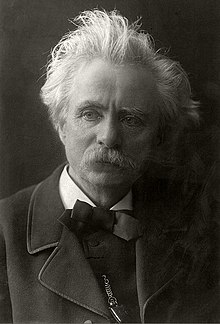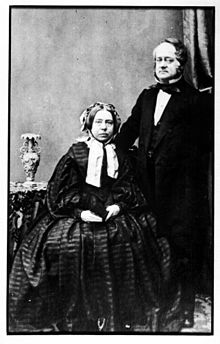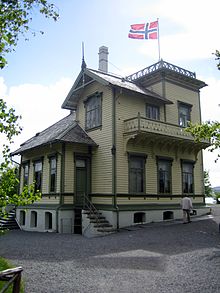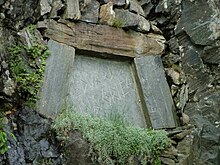Edvard Grieg
Edvard Hagerup Grieg [ ˈɛdʋɑɖ ˈhɑːgəɾʉp ˈgɾɪg ] (born June 15, 1843 in Bergen , Norway ; † September 4, 1907 ibid) was a Norwegian pianist and composer of the Romantic period . He was best known for the Peer Gynt Suite he composed .
Life
family
Edvard Grieg (in German texts also as Edward Grieg and Eduard Grieg ) was born in 1843 as the fourth of five children in Bergen, western Norway. His father Alexander Grieg was a wealthy merchant and British consul in Bergen. He continued the fish trade founded by his grandfather who immigrated from Scotland in 1779.
His mother Gesine (née Hagerup) was sent as a young girl by her parents to train as a composer Albert Methfessel in Altona in Holstein, which was then part of the Danish state . She performed successfully as a pianist and poet in Bergen and was one of the most respected piano teachers in town. She organized weekly music circles in her house, in which, in addition to instrumental works, parts from operas were performed. In his autobiographical sketch My First Success , published in 1903, although its expressiveness is controversial , Grieg attaches decisive importance to his musical inspiration to the impressions he gathered in the lively commercial and cultural center:
“In this way, when I was allowed to go to a funeral or attend an auction as a little boy, I was able to report exactly what impression the incident had made on me. If I had been forbidden to pursue these childish instincts, who knows whether my imagination would not have been suppressed and driven in another direction that was alien to my true nature. "
schooldays
From the age of six he received regular piano lessons from his mother. At the age of nine he began to design his first own compositions . Many piano pieces from his youth have survived, some of which were later published in the complete edition.
His school days were rather unfavorable. After elementary school he graduated from Tanksche Schule , a secondary school focused on new languages, mathematics and natural sciences, which was less suited to the artistically and musically inclined Edvard. The teachers met his interest in music and composition with mockery and cynicism. Grieg in 1903 when he was at school: "Its roughness, its coldness, its materialism - all that was so frightening for my nature."
Because of this, he had to repeat the third grade. It has been alleged that Grieg's negative experiences during his school days continued to affect his dealings with the teachers at the conservatory. This opinion contradicts studies that attest the teachers benevolent recognition of their talented pupil.
Studied in Leipzig
The visit and the positive assessment of the boy's musical abilities by Ole Bull , the well-known violinist and pioneer of his own Norwegian music and culture, in 1858 finally led to Grieg studying at the Leipzig Conservatory .
There he studied from 1858 to 1862 with Carl Reinecke , Louis Plaidy , Ernst Ferdinand Wenzel and Ignaz Moscheles . Grieg later described his studies in Leipzig very critically. He had hardly learned anything in the non-inspiring and conservative lessons and his shortcomings in piano technique were partly due to the teaching methods customary at the conservatory. With his first piano teacher, Louis Plaidy, he only had to practice mindlessly etudes and other pieces by Czerny , Kuhlau and Clementi . He was not made familiar with works by more modern composers. Grieg was able to gain more from the later lessons with Ernst Ferdinand Wenzel, whom he held in high esteem. Grieg's harmony lessons were too conservative. His teachers criticized a. a. the strong tendency towards chromatic design already found in Grieg's compositions back then. A string quartet composed by Grieg for his teacher Carl Reinecke in 1861 was removed from the program of a public concert because the influential violinist Ferdinand David considered it too futuristic.
In 1862 he returned to Bergen with a stopover in Karlshamn , Sweden , where he made his debut as a pianist .
Stations in Europe
In 1863 he moved to Copenhagen . The encounter with Rikard Nordraak, who died early, gave him decisive musical impulses . In 1864, together with Nordraak, EC Horneman and JG Matthison-Hansen, he founded the Euterpe Concert Society in Copenhagen to cultivate new Scandinavian music.
In 1866 he moved to Christiania . In 1867 he married his cousin Nina Hagerup in Copenhagen . In 1868 the only daughter Alexandra was born, who died at the age of 13 months. Franz Liszt impressed Grieg's violin sonatas. A grant from a legacy of the city of Christiania enabled the young artist to travel to Rome in 1869/70 , where he was given an audience with Liszt. His friend August Winding accompanied him on this trip .
From 1874 he lived with state pay as a freelance composer partly in Bergen, partly in Oslo, partly in Lofthus on the Sørfjord , a foothill of the Hardangerfjord . In the autumn of 1875, both of his parents died in quick succession - a stroke of fate that Grieg composed in the ballad in G minor, Op. 24 for piano.
As a pianist and conductor, he went on numerous concert tours in Europe: in addition to Norway, also in Sweden, Denmark, Germany, England, France, the Netherlands, Italy, Austria, Poland, the Czech Republic and Belgium. Most of the time he traveled with his wife, who was a soprano but also mastered the piano. When she performed together, he accompanied her as a singer on the piano, and occasionally performed piano works with her for four hands . From 1880 to 1882 Grieg was conductor of the orchestra of the music society "Harmonie" in Bergen.
During a visit to England in 1888 Grieg got to know Reformation-anti-Trinitarian Unitarianism and since then has known himself as a Unitarian.
Troldhaugen
In 1885 Grieg moved into the "Troldhaugen" house in the hamlet of Hop south of Bergen. Today the Grieg Museum is located there.
In the context of the Dreyfus affair , Grieg declined in a public statement in 1899 the invitation of Édouard Colonne to conduct his own concert on the grounds that he could not travel to France because of the affair and the contempt of law and jurisprudence practiced with it:
“Thank you very much for your kind invitation, I regret that after the outcome of the Dreyfus Trial I cannot make up my mind to come to France. Like all non-French people, I am outraged by the injustice in your country and therefore unable to enter into any relationship with the French public. Forgive me for feeling this way and try to understand my feelings. "
He then received letters of abuse and threats that were partly anti-Semitic in color. In 1903, before Dreyfus was acquitted, he accepted Colonne's renewed invitation. At the concert at the Théâtre du Châtelet in Paris , Grieg had to endure a whistling concert from the French audience. In the summer of 1906, his colleague, the Norwegian composer Johan Halvorsen , wrote to him on the occasion of the publication of the Peasant Dances (Slåtter) op. 72 about the French’s newly discovered enthusiasm for “le nouveau Grieg”.
Edvard Grieg died of emphysema on September 4, 1907 in Bergen .
Famous companions

Edvard Grieg and his wife Nina were friends with Peter Tchaikovsky , the most famous Russian composer of his time in the western world. Although his style could not be easily compared with that of Grieg, reviewers felt a kind of "musical kinship" between the two. In France there was therefore talk of Russian and Norwegian dominance in classical music at the end of the 19th century.
On his many travels in Europe, Grieg met Johannes Brahms , Max Bruch , Clara Schumann and Franz Liszt, among others . Although Brahms and Tchaikovsky did not particularly appreciate each other's music, Grieg was able to develop and maintain a sincere relationship with both of them.
Towards the end of his life, Grieg dealt more and more with contemporary music. He praised Hugo Wolf's songs , studied the 5th Symphony by Gustav Mahler and commented on the works of Max Reger , Richard Strauss and Carl Nielsen .
Grieg was downright adored by the German-born English composer Frederick Delius , who, particularly at the beginning of his composing career, repeatedly sought the advice of his Norwegian senior colleague.
Work and reception

Similar to the Mighty Heap in Russia with Mussorgsky at the head, Grieg merged elements of folk music from his homeland - such as empty fifths , sharply emphasized dance rhythms , fluctuating between modal and major minor keys - with the technical achievements of late Romanticism. His harmony partly points to Impressionism and in some compositions such as Klokkeklang (Glockenklang, from the cycle of lyric pieces, op. 54 ) is of unique radicalism. Above all abroad, he is regarded as the ultimate Norwegian composer (which is a little unfair to his colleague Johan Svendsen ).
Grieg's greatest importance lies in piano and chamber music ; his lyric pieces were and are widespread in domestic music . Of his orchestral works, the two Peer Gynt Suites , the Suite From Holberg's Time and the Piano Concerto are extremely popular to this day.
Outstanding is his string quartet in G minor, Op. 27, which is rated in the encyclopedia The music in past and present as one of the most remarkable compositions of chamber music of the 19th century.
In addition, Grieg also wrote valuable, but less well-known choral and song literature. His cycle “Haugtussa” after Arne Garborg , which addresses the youth and first love of a girl who has a “second face” and is connected to the spirit world of the mountains, is generally considered to be the highlight of the latter .
It is little known that the Danish composer Niels Wilhelm Gade inspired some of Grieg's early works. I.a. Grieg's first symphony was written at Gade's request when the two met in Copenhagen. But Grieg was never, as is often rumored , Gade's pupil.
The influence of Grieg in the works of the following generation of composers can be seen in many ways. Even during his lifetime, individual compositions by the Swede Emil Sjögren and the Hungarian Árpád Doppler Grieg's popularity, which his publisher Max Abraham also noticed. The early piano music by Dohnányi Ernő (in Germanized spelling Ernst von Dohnányi ), which Grieg valued as an interpreter of his own works, shows many Brahmsian as well as Griegian features. Grieg's aftermath becomes very clear in the string quartets by Claude Debussy and Carl Nielsen , one of which is dedicated to Grieg. Even his former opponent Niels Wilhelm Gade gave his last string quartet a small reminiscence of his Norwegian colleague. Among the many others who explicitly referred to Grieg in their compositional work or in coded form in their music, one can find Frederick Delius , Maurice Ravel , Sergej Rachmaninow , Dmitrij Shostakowitsch , Sigfrid Karg-Elert , Nicolai Medtner and Béla Bartók .
Honors

Edvard Grieg received numerous awards. For example, he was appointed a member of the Royal Swedish Music Academy , the Academy of Arts in Berlin and the French Legion of Honor ; in his home country he was honored with the Grand Cross of the Order of Saint Olav .
He was also awarded two honorary doctorates in music, in May 1894 from Cambridge University (alongside Camille Saint-Saëns and Peter Tchaikovsky ) and in May 1906 from Oxford University .
The Norwegian postal administration issued numerous postage stamps in honor of the composer .
In 1970 the biography film Song of Norway was made . It is based on the musical of the same name from 1944.
In 1991 the asteroid (4872) Grieg was named after him. Mount Grieg on Alexander I Island in Antarctica has been named after him since 1961 .
The Edvard Grieg oil field discovered off the Norwegian coast in 2007 and the drilling platform built on it were named after the composer.
Works (selection)
- Dramatic music
-
Sigurd Jorsalfar , incidental music op. 22 based on the drama of the same name by Bjørnstjerne Bjørnson , from it
- a Suite , op.56 (Prelude in the Königshalle, Intermezzo / Borghilds Traum, Homage March)
-
Peer Gynt , incidental music op. 23 based on the drama of the same name by Henrik Ibsen , from it
- two suites :
- Suite No. 1, op.46 (Morning Mood, Åse's Death, Anitra's Dance, In the Hall of the Mountain King )
- Suite No. 2, op.55 (The Robbery, Arabic Dance, Peer Gynt's Homecoming, Solvejg's Song)
- two suites :
- Opera fragment Olav Trygvason op. 50
-
Sigurd Jorsalfar , incidental music op. 22 based on the drama of the same name by Bjørnstjerne Bjørnson , from it
- Orchestral music
- Symphony No. 1 in C minor (1863/4)
- Symphony No. 2 In Spring (fragment)
- Symphonic Dances, op.64
- Concert Overture In Autumn op.11
- Norwegian Dances op.35
- Concerto for piano and orchestra in A minor, Op. 16
- Piano music
- Humoresques op.6
- Sonata for Piano in E minor op.7
- Ballade for piano in G minor op.24
- Folk music arrangements op.29 (improvisations), op.66 (Norwegian folk tunes) and op.72 (peasant dances Slåtter )
- Wedding on Troldhaugen op.65, no.6
- Lyric pieces for piano, several albums, were created in different creative periods
- Suite From Holberg's Time op. 40, later arranged for string orchestra
- Chamber music
- Sonata No. 1 for violin and piano in F major op.8 (1865)
- Sonata No. 2 for violin and piano in G major op.13 (1867)
- String Quartet in G minor, Op. 27 (1877–1878)
- Piano trio in A major (?), Unfinished (1878)
- Sonata for violoncello and piano in A minor, Op. 36 (1882–1883)
- Sonata No. 3 for violin and piano in C minor, op.45 (1886)
- String quartet in F major, unfinished (1891)
- Piano Quintet in B flat major, unfinished (year?)
- Songs based on texts by Heinrich Heine , Johann Wolfgang von Goethe , Henrik Ibsen a . a. op.4, op.25, op.39 and op.48
- Song cycle Haugtussa by Arne Garborg Op. 67
- Choral works
- Four psalms for baritone and mixed choir a cappella op.74
- Ave Maris Stella
- butterfly
research
In 1995 the Edvard Grieg Research Center was founded at the Westphalian Wilhelms University in Münster . In 2005 it was relocated to the University of the Arts in Berlin , reopened there on January 27, 2006 under the direction of Patrick Dinslage and relocated to the University of Leipzig in February 2016. The Edvard Grieg Research Center organized the International Edvard Grieg Congress Berlin 2009 from May 13-16, 2009. On June 15, 2015, the International Edvard Grieg Symposium Berlin 2015 took place at the Berlin University of the Arts. On March 16, 2011, the Center for Grieg Research was opened at the University of Bergen. Patrick Dinslage and Arvid Vollsnes (University of Oslo) were the founding members of the center as visiting professors for four years. Arnulf Mattes has been in charge since August 1, 2015. From October 13 to 16, 2016, the Institute for Musicology at the University of Leipzig invited to the international musicological conference “Edvard Grieg, his environment, his successors. New Research ”.
In 1995, with the participation of Joachim Dorfmüller, the Deutsche Edvard-Grieg-Gesellschaft e. V. founded in Wuppertal .
See also
literature
German:
- Finn Benestad and Dag Schjelderup-Ebbe : Edvard Grieg - man and artist. German publishing house for music, Leipzig, 1993, ISBN 3-370-00291-4 .
- Hella Brock : Edvard Grieg: a biography . Schott Musik International, Mainz etc. 1998. ISBN 978-3-254-08375-3 .
- Hella Brock: Edvard Grieg in music lessons - considerations under intercultural and polyesthetic aspects. Hildegard Junker Verlag Altenmedingen 1995.
- Hella Brock: Edvard Grieg as a music writer . Hildegard Junker Verlag, Altenmedingen 1999. ISBN 978-3-928783-81-1 .
- Hella Brock: Grieg's music to Ibsen's Peer Gynt - enrichment and independence. Hildegard Junker Verlag, Altenmedingen 2001
- Patrick Dinslage: Edvard Grieg and his time . Laaber-Verlag, Laaber 2018. ISBN 978-3-89007-816-8 .
- Edvard Grieg: Correspondence with the music publisher CF Peters (1863–1907) , ed. by Finn Benestad and Hella Brock. Peters, Frankfurt / Main, 1997, ISBN 3-87626-010-8 .
- Edvard Grieg: Correspondence , ed. by Klaus Henning Oelmann. Hänsel-Hohenhausen, Frankfurt / Main, 1994–, ISBN 3-8267-1123-8 ; ISBN 3-937909-55-9 (series).
- Edvard Grieg: Thematic Bibliographical Catalog of Works , presented by Dan Fog, Kirsti Grinde and Øyvind Norheim. Henry Litollfs Verlag, Frankfurt / Main 2008, ISBN 978-3-87626-990-0 .
- Ekkehard Kreft: Grieg's Harmonics. Peter Lang GmbH, Frankfurt / Main 2000, ISBN 3-631-35995-0 .
- Hanspeter Krellmann: Edvard Grieg. Rowohlt, Reinbek 1999, ISBN 3-499-50430-8 .
- Hanspeter Krellmann: Grieg's Lyric Piano Pieces - A musical work guide. Verlag CH Beck, Munich, 2008, ISBN 978-3-406-44815-7 .
- Klaus Henning Oelmann: Edvard Grieg - attempt at an orientation. Hänsel-Hohenhausen, Egelsbach, St. Peter Port (UK), 1993, ISBN 3-89349-485-5 .
- Klaus Henning Oelmann: Edvard Grieg's string quartet op. 27 - reflections on tradition, composition and reception. Engers Colloquia Castle on Chamber Music, Vol. 4, Villa Musica Foundation, Neuwied, 2007, pp. 387–405, ISBN 978-3-9802665-7-4 .
- Joachim Reisaus: Grieg and the Leipzig Conservatory. Books on Demand GmbH, 2002, ISBN 978-3-8311-4069-5 .
- Ute Schwab and Harald Herresthal: Edvard Grieg and his relationship with Carl Reinecke. Studia musicologica norvegica 25, Scandinavian University Press, Oslo, 1999, p. 157 ff.
- Ulrich Tadday (Hrsg.): Series of music concepts - Edvard Grieg. Edition Text and Criticism, Munich, 2005, ISBN 3-88377-783-8 .
- Jing-Mao Yang: The “Grieg Motif” - On the recognition of Edvard Grieg's personal style and musical thinking. Bosse, Kassel 1998, ISBN 978-3-7649-2634-2 .
English:
- Kortsen, Bjarne (Ed.) (1972): Grieg The Writer. 2 vol., Editio norvegica, Bergen.
Norwegian:
- Benestad, Finn / Schjelderup-Ebbe, Dag (2007): Edvard Grieg - mennesket og kunstneren . H. Aschehoug & Co. (W. Nygaard), Oslo.
- Bredal, Dag / Strøm-Olsen, Terje (1992): Edvard Grieg - Musikken er en kampplass . Aventura Forlag A / S, Oslo. ISBN 82-588-0890-7 .
- Dahl Jr., Erling (2007): Edvard Grieg - En introduksjon til hans liv og musikk . Vigmostad and Bjørke, Bergen. ISBN 978-82-419-0418-9 .
- Johansen, David Monrad (1956): Edvard Grieg . Gyldendal Norsk Forlag, Oslo.
swell
- ^ Gerhard Schjelderup and Walter Nieman: Edvard Grieg - biography and appreciation of his works , CF Peters, Leipzig, 1908, p. 8
- ^ Edvard Grieg: List of his works with an introduction: My first success. Leipzig, 1910, p. 3
- ↑ Joachim Reisaus: Grieg and the Leipzig Conservatory - Investigations into the personality of the Norwegian composer Edvard Grieg with special consideration of his years of study in Leipzig. Dissertation, Leipzig, 1986, p. 57 ff.
- ^ Edvard Grieg: List of his works with an introduction: My first success. Leipzig, 1910, p. 7
- ↑ Ute Schwab and Harald Herresthal: Edvard Grieg and his relationship with Carl Reinecke. Studia musicologica norvegica 25, Scandinavian University Press, Oslo, 1999, p. 157 ff.
- ↑ Rebekah Jordan: Edvard Grieg - Between Two Worlds , McMaster University, 2003, pp. 7 to 10
- ↑ Konsertprogram bergenbibliotek.no (Norwegian), see Konserter hvor Edvard og Nina Grieg opptrådte (concerts at which Edvard and Nina Grieg performed), including the individual countries.
- ↑ Lena Haselmann: Nina Grieg article in the MUGI project (Music and Gender on the Internet) at the Hamburg University of Music and Theater.
- ↑ Ali Groner: Unitarianism: A Religion of Modernity . In: Hans Gerald Hödl (Hrsg.): Religions after secularization . Berlin 2011, ISBN 978-3-643-50278-0 , pp. 164 .
- ↑ Finn Bøe: trek av Edvard Grieg personlighet . Tanum, Oslo 1949, p. 37 .
- ^ Edvard Grieg: The correspondence with the music publisher CF Peters 1863–1907 , ed. by Finn Benestad and Hella Brock, Peters, Leipzig, Frankfurt / Main, London, New York 1997, p. 420
- ↑ Ibid., P. 423. Other authors accused Grieg of “naivety” in a highly explosive political discussion that “concerned the conscience of an entire nation”. FZMw ( Memento from July 10, 2012 in the web archive archive.today )
- ↑ Harry Goldschmidt: Edvard Grieg - Some reflections on the fiftieth anniversary of his death; in: Harry Goldschmidt: To the cause of music - speeches and essays , Verlag Philipp Reclam jun. Leipzig, 1970, pages 160 and 161
- ↑ Jean-Luc Caron: Edvard Grieg - Le Chopin du Nord - La vie et l'œuvre, Editions l'Age d'Homme, 2003, pages 132 and 133
- ↑ Grieg, Peters Briefwechsel, op.cit. P. 607
- ↑ Bjarne Kortsen (Ed.): Grieg The Writer. 2 vol., Editio norvegica, Bergen 1972
- ↑ Klaus Henning Oelmann: Edvard Griegs Briefwechsel vol. 2, Hänsel-Hohenhausen, Egelsbach 1994
- ^ Association of authors of German composers and musicologists: Contributions to musicology, Volume 33, Verlag Neue Musik, 1991, page 69
- ↑ a b Klaus Henning Oelmann: Edvard Grieg's string quartet op. 27 - reflections on tradition, composition and reception. Engers Colloquia Castle on Chamber Music, Vol. 4, Villa Musica Foundation, Neuwied, 2007, pp. 387–405
- ↑ Mogens Christensen: reflections on the concept of tonicity in Edvard Grieg and Carl Nielsen, in: The congratulators come. Edvard Grieg for his 150th birthday, ed. von Mogens Christensen et al., Egelsbach St. Peter Port New York 1993 (Deutsche Hochschulschriften Vol. 814)
- ↑ Edvard Grieg . To: Saarland University . Retrieved February 8, 2015.
- ↑ Minor Planet Circ. 18648
- ^ Lundin Petroleom: Edvard Grieg (engl.)
- ↑ See for example Edvard Grieg, Complete Piano Works in 5 Volumes. Koenemann Music, Budapest.
- ^ Edvard Grieg Research Center Leipzig
Web links
- The Grieg collection of the city library in Bergen / Norway
- Works by and about Edvard Grieg in the catalog of the German National Library
- Works by and about Edvard Grieg in the German Digital Library
- Edvard Hagerup Grieg - biography, catalog raisonné, bibliography, appreciation
- Edvard Grieg - Leipzig Memorial and Meeting Place V. - Life and work in Leipzig
- Lyric Pieces as PDF and MIDI (free)
- Klassika - Grieg: Catalog raisonné
- Sheet music and audio files from Grieg in the International Music Score Library Project
- "The voice of Norway - the composer Edvard Grieg died 100 years ago" ( Deutschlandradio calendar from September 4, 2007 - broadcast manuscript and audio download)
Recordings
- Classic Cat - Grieg - Directory with free recordings
- Song cycle Haugtussa - Solveig Kringlebotn , soprano - Malcolm Martineau, pianist
- audite edition - complete recording of the symphonic works with the WDR Symphony Orchestra Cologne under Eivind Aadland
- Edvard Grieg: Lyric Pieces: Playlist [1]
| personal data | |
|---|---|
| SURNAME | Grieg, Edvard |
| ALTERNATIVE NAMES | Grieg, Edvard Hagerup; Grieg, Eduard; Grieg, Edward |
| BRIEF DESCRIPTION | Norwegian composer |
| DATE OF BIRTH | June 15, 1843 |
| PLACE OF BIRTH | Mountains |
| DATE OF DEATH | 4th September 1907 |
| Place of death | Mountains |





